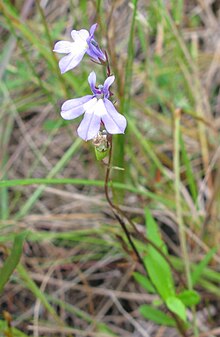Lobelia kalmii
| Lobelia kalmii | |
|---|---|

| |
| Lobelia kalmii | |
| Scientific classification | |
| Kingdom: | Plantae |
| Clade: | Tracheophytes |
| Clade: | Angiosperms |
| Clade: | Eudicots |
| Clade: | Asterids |
| Order: | Asterales |
| Family: | Campanulaceae |
| Genus: | Lobelia |
| Species: | L. kalmii
|
| Binomial name | |
| Lobelia kalmii | |
Lobelia kalmii is a species of flowering plant with a distribution primarily across Canada[2] and the northern United States in temperate and boreal regions.[3] It was formerly known as Lobelia strictiflora (Rydb.) Lunell and has a variety of English names including Kalm's lobelia, Ontario lobelia and Brook lobelia.
Growth
Lobelia kalmii is a small plant (10 – 40 cm) that grows in wet environments such as bogs, wet meadows, and rocky shorelines, including wet alvars, where it grows in calcareous soil or cracks between limestone rocks.
It has blue flowers with a white center. It has thin upper leaves and spatulate basal leaves.[4] The plant starts flowering in July and lasts into September.
Cultivation and uses
Although other species of Lobelia are cultivated for ornamental purposes, the small (1 cm) flowers of Lobelia kalmii have not endeared this plant to growers. However, it can be found through on seed exchanges among native plant enthusiasts.[5] Its hardy nature may allow it to produce masses of scattered plants within downspout rock gardens.
Traditional use
Native Americans used Lobelia to treat respiratory and muscle disorders, and as a purgative.[citation needed] The species used most commonly in modern herbalism is Lobelia inflata (Indian Tobacco).[6]
References
- ^ "Lobelia kalmii". IUCN Red List of Threatened Species. 2019. 2019. Retrieved 18 June 2019.
{{cite journal}}: Invalid|ref=harv(help) - ^ Natural Resources Canada Plant Hardiness Site
- ^ USDA PLANTS Profile
- ^ Peterson, Roger Tory; McKenny, Margaret (1968), A Field Guide to Wildflowers: Northeastern/Northcentral North America, Houghton Mifflin
{{citation}}: Unknown parameter|lastauthoramp=ignored (|name-list-style=suggested) (help) - ^ North American Native Plant Association Seed Exchange Archived 2008-12-25 at the Wayback Machine
- ^ "Lobelia". EBSCO Complementary and Alternative Medicine (CAM) Review Board. January 2006. Retrieved 2007-09-12.

